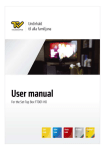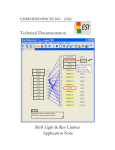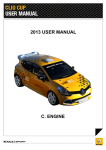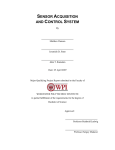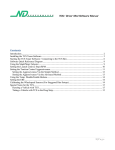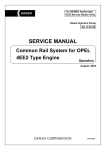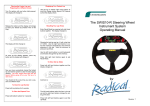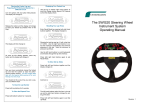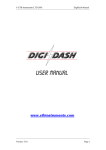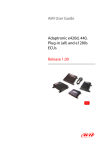Download G - Softwares - V-line organización
Transcript
2013 USER MANUAL G. SOFTWARES / DATAS ACQUISITION 98CUP_2013 Release G SOFTWARES / DATAS ACQUISITION CONTENTS G SOFTWARES / DATAS ACQUISITION G.1 DATAS ACQUISITION G.1.1 PRESENTATION G.1.2 DATALOGGER G.1.3 COMMUNICATION G.2 TOOLSET G.2.1 DATAS DOWNLOADING G.2.2 LIVE PARAMETERS MONITORING G.2.3 DASHBOARD CONFIGURATION G.2.3.1 QUALIFYING MODE (QM) G.2.3.2 SEND A CIRCUIT MAP G.2.3.3 ICD SETUP G.2.3.4 SHIFTLIGHTS CONFIGURATION G.2.3.5 BEACON CONFIGURATION G.3 DATA ACQUISITION CHANNEL LIST G.4 DATA ANALYSIS / TOOLBOX G.4.1 CONFIGURATION VIA SOFTWARE G.4.2 OPENING DATAS G.4.3 ANALYZING DOWNLOADED DATA G.4.3.1 DISPLAYING A CHANNEL G.4.3.2 CHANGING THE REFERENCE AXIS (TIME/DISTANCE) G.4.3.3 COMPARING LAPS G.4.3.4 GRAPH TYPE G.4.3.5 GRAPH PROPERTIES G.4.3.6 CREATE A TRACK MAP G.4.3.7 CREATE A XXX.QM FILE G.4.3.8 TRAJECTORY COMPARISON G.4.4 SHORTCUT KEYS C-2 2 3 3 3 3 6 6 8 9 9 11 12 13 14 18 23 23 23 24 24 24 25 25 26 27 30 31 33 98CUP_2013 Release G.1 DATAS ACQUISITION G.1.1 PRESENTATION The vehicle is supplied with an USB Stick containing the following software applications: - TOOLSET v3.x o Check live parameters (engine, Gearbox, chassis…etc) o Downloading datas recorded in the datalogger o Configure your dashboard - TOOLBOX 6.2 o Data acquisition analysis All these softwares are compatible with Windows XP, Vista and 7.0 G.1.2 DATALOGGER The data logger is integrated in the dashboard. The logger’s memory is 1 Gb. Its operational temperature range is 10°C to 60°C. Weight : 750g The dashboard is plugged to the chassis loom (C4) G.1.3 COMMUNICATION The communication between the computer and the dashboard is made by ETHERNET Protocol (TCP/IP) using a Network card. Communication Wire (8201 414 870) Ethernet cable / Category 5E CANNON ITT 12 Pins Computer side Dialog connector side C-3 98CUP_2013 Release Dialog connector: The dialog connector (Chassis loom C15) is fitted instead of the original right aerator. Network configuration / IP Address : You first have to enter the correct IP Address To do so, go to “Network Connections” : “Start” menu “Parameters” “Network Connections” Then make a right click on the good “local network” to choose “properties” With Windows XP, select “internet protocol TCP/IP” and click on “properties” NOTE : for Windows Vista & 7.0 choose “internet protocol” and “TCP/IP v4” Fill the corresponding areas as below: IP ADDRESS : 172.16.255.124 SUBNET MASK : 255.255.0.0 When everything is completed as described above, click on “OK” C-4 98CUP_2013 Release Communication Speed : It may be necessary to reset your PC communication speed to “Automatic”, following the instructions below: Click on “Start” menu “Parameters” “Network Connections” Right click on “local network” to choose “properties” Click on “configure” and choose the tag “advanced” Select « speed and duplex » line and choose « auto negotiation » NOTE : Depending on the Windows version, this line can be named differently. The most important thing is to choose the one which mentions the communication speed. C-5 98CUP_2013 Release G.2 TOOLSET Toolset software will allow you to: - Check live parameters (engine, Gearbox, chassis…etc) Download datas recorded in the datalogger Configure your dashboard (shiftlights, qualifying mode, beacons,…etc) Make and send the datas acquisition setup G.2.1 DATAS DOWNLOADING Install and then open the software Toolset 3.x on your computer. By default, the installation software proposes you the following destination: C:\Program files\Pi Toolset Reminder : Change the computer IP address to connect to the car: IP address: 172.16.255.138 Subway Mask: 255.255.0.0 Offload Path configuration : On the top menu, Go to “Settings” / “Data Offload” Then you can choose the : “root path” “relative path” The root path is combined with the Relative Path to form the complete path and filename of the downloaded file (xxx.pds). By clicking on you can modify all of these parameters. It’s possible to include the exact date, the session, the driver name,…etc The “Preview” indicates : The name of the downloaded file where the file will be saved Offload Conditions : We also recommend you to configure the general offload settings as indicated above. Don’t forget to “Save” after every modification C-6 98CUP_2013 Release Devices : When you connect to a new dashboard system for the first time, you have to add and save this system : On the top menu, Go to “Devices” Click on to add a device : the following windows appears and indicate the ICD-Lite-RST serial number (same number written on the back of the dash) Select it and click on The ICD is now saved and will be automatically detected every time you will connect to it. You can saved as many ICD as you want in your Toolset configuration To select the ICD you want to communicate with, it is necessary to click on A “tick” appears near the ICD selected NOTE : on, the right column, it is possible to change the ID, the name and to add comment for this dashboard Data downloading : On the top menu, Go to “Data” You first have to fill the settings of the outing you want to down load: 1) Click on the data file you want to download (DO NOT click on the arrow pointed to the bottom to avoid automatic offload) 2) The right column appears, displaying the outing number, the date and the Run time. We recommend you to fill the track name, driver name, car name, and to add short and long comment if you want NOTE : Filling this area will allow you to save the downloaded file following the offload path defined on previous page 3) Click on the arrow pointing to the bottom to start downloading Select an Outing to start the downloading The corresponding outing is saved to the path chosen previously. 1) Click here 2) Fill this area 3) Click on the arrow to offload datas offloading in progress C-7 Datas offloaded 98CUP_2013 Release G.2.2 LIVE PARAMETERS MONITORING There is not standard “live datas” configuration. You have to make it by yourself. On the top menu, Go to “Live Data” List of pages : You can add as many pages as you want by clicking on A list of blank pages will appear on the left column. You can rename the pages as you want : ENGINE, GEARBOX…etc by clicking on the name area It is possible to remove a page by clicking on Pages configuration : On each pages, you can now add the channels you want for live monitoring : Add a column by clicking on Then click on to display the list of available channels and choose the desired channel(s) See the channel list on § G.3 You can choose between 2 types of display : • Standard • Compact C-8 98CUP_2013 Release G.2.3 DASHBOARD CONFIGURATION Toolset also allows you to configure the following parameters: - Shift lights thresholds Beacon type configuration (single beacon receiver or GPS receiver) Qualifying mode configuration Circuit map G.2.3.1 Qualifying mode (QM) The Qualifying Mode allows drivers to compare in live their current lap to a reference lap according sectors defined in Toolset. Qualifying mode access : Connect your computer to the right ICD (check that a “tick” is displayed) On the top Menu, go to “Action” and then click on to open the qualifying mode : Qualifying mode configuration : 3 modes are available and are listed below: MODE 1 = AUTOMATIC MODE Distance based : Autolearn The ICD will automatically learns the track length and then split the lap into a number of segments The reference lap can be learnt as : - The fastest lap - An addition of all best segments It is possible to define from 2 to 128 segments The track is divided in equal length portions depending on the number of segments chosen. For example, if 10 is chosen and the track length is 5,000m, the driver will observe on the dashboard a new split every 500m. NOTE : by default, this mode is enable with the following configuration : - Fastest lap learned - 128 segments When the configuration is achieved, click on C-9 98CUP_2013 Release MODE 2= SEMI-AUTO MODE Distance based : PDS File reference A xxx.pds file (downloaded file, see G.2.1) is selected as the reference lap (from the connected ICD or another one) This reference lap is used to determine the track length and the track is automatically split into segments. Click on to browse your computer and load the outing (.pds file) The “file properties” displays the main information of this outing (driver, track name, date…etc) “datum lap” indicates the reference lap time selected. By default the best lap of the outing is chosen. The reference lap can be learnt : - As it was created (init segment times) - As the fastest lap - As an addition of all best segments It is possible to define from 2 to 128 segments (as for MODE 1). When the configuration is achieved, click on MODE 3 = MANUAL MODE Distance based : QM File generation A xxx.qm file is created using a xxx.pds file in the TOOLBOX software (see G.4 Datas analysis) The user : - Loads a xxx.pds file on TOOLBOX - Defines the segments exactly where he wants - Exports file and saves it as a xxx.qm - This xxx.qm file is used in Toolset qualifying mode Segments generated in TOOLBOX from a .pds file This reference lap is used to determine the track length and the positioning of the defined segments Click on to browse you computer and load the outing (.qm file) The “file properties” displays the main information of this outing (driver, track name, date…etc) “datum lap” reminds the reference lap time selected The reference lap can be learnt as for MODE 2: When the configuration is achieved, click on C-10 98CUP_2013 Release Corresponding dashboard page : The Qualifying mode is visible by the driver on “driver page” n°2 (refer to chapter BPresentation) + / - : comparison with the reference lap selected after each segment Bargraph : 1 bar = 1 tenth (ahead or late) Split time: stay displayed 5 sec after the end of the segment NOTE : Depending on segment number defined, the split time remains displayed +/- long time When 128 segments are defined, we can consider that it’s a “live update” G.2.3.2 Send a Circuit Map This function allows loading a circuit map (xxx.bmp file) on “driver page” n°3 (refer to chapter B-Presentation) Circuit Map change: - Connect your computer to the right ICD (check that a “tick” is displayed) - On the top Menu, go to “Action” and then click on Refresh configuration to open the “send image” mode: the by clicking on - Make a double Click on the circuit map (a browser opens) - chose a (.bmp file) circuit - the selected circuit appears on this page to confirm that it has correctly been uploaded NOTE : The circuits can be available form Renault Sport Extranet or created by the user. C-11 98CUP_2013 Release G.2.3.3 ICD SETUP The configuration of many information displayed or accessible through the ICD (as for example a part of the data acquisition channels list, the CAN decode…etc) is managed by a “SETUP” which has to be sent to the dash after every update. Each SETUP is named as described below: <Year> Clio CUP Base setup <Version> - <Tyre diameter> <Tyre manufacturer>.toolset 2 base setups will be available in the future 2 tyres manufacturers = 2 different tyre diameters Setup 1 : 2013 Clio CUP Base Setup Vx.x – 610 MICHELIN.toolset Setup 2 : 2013 Clio CUP Base Setup Vx.x – 620 DUNLOP.toolset Both 2 setups are strictly identical except the 3 speed channels of the data acquisition channel list: o Speed_FL o Speed_FR o Speed Indeed, as the MICHELIN and the DUNLOP Tyre have a different diameter, the Speed (displayed and logged) is calculated differently. After every tyre change, we strongly recommend you to load the right setup (corresponding to the tyre used) in the ICD to avoid confusion on Speed calculation NOTE : - By Default, every brand new ICD is delivered with a MICHELIN Setup - As 2013 season will exclusively use MICHELIN tyre, only the setup 2013 Clio CUP Base Setup Vx.x – 610 MICHELIN.toolset will be available The last Setup version will always be available on the Renault Sport Extranet / area SOFTWARES. Don’t forget to download the last version regularly Setup access : - Connect your computer to the right ICD (check that a “tick” is displayed) - On the top Menu, click on ‘SETUP” - It is possible to : - Import a setup : click on - Read a setup from the active device : click on . Browse you computer and load it C-12 98CUP_2013 Release Setup opening : Make a double click on the Setup to open it Setup uploading and saving : To send a setup to the device, click on To save a setup on your computer, click on (save) or (save as) The user has the possibility to configure 2 important parameters in the setup : - The Shiftlight LEDS thresholds - The beacon type G.2.3.4 Shiftlights configuration This function allows configuring the thresholds of the shiftlights LEDs lighting up (refer to chapter B-Presentation) Shiftlight LEDs configuration access : - Connect your computer to the right ICD (check that a “tick” is displayed) - Open a setup (check the tyre type) - In the Home Menu, click on to open the shift lights configuration mode : Set the 8 thresholds Configuration by default Send the setup to the device by clicking on C-13 LEDS Reminder: the Engine limiter is 6,500rpm 98CUP_2013 Release G.2.3.5 Beacon configuration This function allows configuring the beacon mode. Beacon configuration access : - Connect your computer to the right ICD (check that a “tick” is displayed) - Open a setup (check the tyre type) - In the Home Menu, click on to open the beacons configuration mode: 2 main modes available: MODE 1: classic beacon receiver Reminder (chapter F-wiring looms): The Lap beacon is fitted on rear left or rear right roll cage tube and must be visible through door window. It allows: - the Lap decomposition in the data acquisition system - Lap time displayed on the dashboard CHASSIS LOOM C21 To “cut” the laps using the lap beacon, the presence of the corresponding COSWORTH track wall beacon (7711166112) is required: Configuration: In Beacon type, select “10 -channel beacon receiver” During every Race meeting, only the standard beacon receiver (as indicated above) must be selected. The track beacon is fitted by the Renault Sport championship organizer. C-14 98CUP_2013 Release MODE 2 : GPS beacon receiver Reminder (chapter F-wiring looms): The GPS Receiver is an option. It is plugged directly on the chassis loom near the dialog connector and must be fitted as shown below: GPS receiver fitting (magnetic) It Allows: - CHASSIS LOOM C20 the Lap decomposition in the data acquisition system to compare trajectories in data acquisition to avoid a track beacon requirement Lap time displayed on the dashboard Configuration : In Beacon type, select “GPS beacon receiver” The GPS beacon must not be used during an event organized by Renault Sport. It must be used only for private or non official testing. To correctly “cut” the lap, it is necessary to fill the start and finish lines GPS coordinates (latitude and longitude) of the corresponding circuit. 2 possibilities: 1) The track GPS coordinates already exists on the library (.kml file), in this case, just load it by clicking on 2) If not, you have to fill the GPS coordinates or to create a new start/finish line circuit using the following procedure : C-15 98CUP_2013 Release GPS Beacon configuration from Google Earth : Introduction: Using Google earth it is possible to create a start finish line that can be used to generate beacon events. The following will guide you through this process. Beacon locations can be created using Google Earth. The following will talk you through creating a beacon location file as well as importing it into Toolset: 1) Download, Install and the Open Google Earth 2) Right Click on “My Places” 3) Click on “add” and then “path” 4) The Edit path window will appear - Enter a name for your "Start Finish Line" - Using the mouse, draw the start finish line as you wish it to be used (you can modify the style and the colour of the line) - The line must be composed of 2 points (start and end) NOTE : This line should completely cross the track in the area you need. A beacon will be triggered every time this line is crossed. C-16 98CUP_2013 Release 5) You can add multiple "Start Finish" lines to a single file if the circuit in question has got multiple lines 6) Once you have created your "Start Finish" line you will need to export it: - Right click on the path and click on “Save Place As…” 7) It is important that you select the *.kml file format that is available with the drop down box 8) Once you have created you "Start Finish" .kml file, it can be imported into Toolset using the Beacons configuration (see page C.15) by clicking on 9) Once you have added the track you will be able to select the Beacon, if you have added multiple paths to a single .kml you will be able to select the one you want from the drop down menu. NOTE : Even if the GPS is not selected as beacon, the GPS coordinates (latitude, longitude, speed, altitude) are still logged in the ICD and allow the Map drawing and trajectory comparison in TOOLBOX software (see G.4 data analysis) During every Race meeting, only the standard beacon receiver (as indicated above) must be selected. Configuring the GPS as a beacon is strictly forbidden. C-17 98CUP_2013 Release G.3 DATA ACQUISITION CHANNEL LIST The following table presents the complete channel list logged in the ICD. “Bit indicator column” indicate if this channel can be considered as a Bit field in TOOLBOX. To facilitate the understanding, except classic channels (brake pressure, accel X and Y, distance, speed…etc), all channels are grouped behind a family name : Dash_ (Cosworth ICD LITE) ECU_ (Cosworth SQ7Di) EN_ (Engine) CBNT_ (XAP CBNT) GB_ (gearbox) QM_ (qualifying mode) GPS_ ICD Channel name Signification Accel_X Longitudinal acceleration Accel_Y Lateral acceleration Accel_Z Vertical acceleration Battery Voltage Battery voltage Brake_Balance Brake balance (% front) Brake_Press_F Front brake pressure Brake_Press_F Offset Front brake pressure offset (must be 0 after a reset procedure) Brake_Press_R Rear brake pressure Brake_Press_R Offset Rear Front brake pressure offset (must be 0 after a reset procedure) CBNT_CMD_Rain Light_Omega Rain light command sent by CBNT CBNT Check 1_Omega CBNT Diagnostic / Always = 0xAA (dec = 170) CBNT Check 2_Omega CBNT Diagnostic / Always = 0x55 (dec = 85) CBNT_SWT_State CBNT_PCM_Diag_1 CBNT_PCM_Diag_2 CBNT_PCM_Diag_3 CBNT_PCM_Diag_4 CBNT switches state (ON or OFF) Pin_H_Stop light switch Pin_G_ Rain light switch Pin_B_Light left switch (Front and rear) Pin_A_light right switch (Front and rear) CBNT status (Ok or fault) Pin_N_ Wheelspeed Pin_M_XAP gearbox actuator Pin_L_+12v output CBNT status (Ok or fault) Pin_T_dash Pin_D_VVT Pin_C_HP pump/waste gate/ pop off Pin_J_ECU Pin_ K_steering wheel Pin_F_ starter excitation Pin_E_geabox barrel unlocking CBNT status (Ok or fault) Pin_H_Stop light Pin_G_rain light Pin_B_Light left switch (Front and rear) Pin_A_light right switch (Front and rear) CBNT status (Ok or fault) Pin_h_g_ignition coil Pin_V_W_low P fuel pump / lambda sensor Pin_R_P_Wiper Pin_f_winscreeen washer C-18 Bit indicator** YES YES YES YES YES 98CUP_2013 Release Dash_Alarm_EN_Air_Temp CBNT state (ON or OFF) Pin_Z_brake light cmd Pin_e_rain light cmd Pin_j_light cmd Pin_S_wiper at ref position Pin_Y_ignition Pin_U_low press fuel pump cmd Pin_X : not used Pin b_c_CAN2 CBNT state (ON or OFF) Pin_N_ Wheelspeed Pin_M_XAP gearbox actuator Pin_L_+12v output CBNT state (ON or OFF) Pin_T_dash Pin_D_VVT Pin_C_HP pump/waste gate/ pop off Pin_J_ECU power Pin_ K_steering wheel Pin_F_ starter excitation Pin_E_gearbox barrel unlocking Battery alarm displayed on ICD Air temp alarm displayed on ICD Dash_Alarm_EN_High_Fuel_Press High Press fuel alarm displayed on ICD Dash_Alarm_EN_Low_Fuel_Press Low press fuel alarm displayed on ICD Dash_Alarm_EN_Oil_Press Engine Oil press alarm displayed on ICD Dash_Alarm_EN_Water_Temp Water temp alarm displayed on ICD Dash_Box_Temp Dashboard temperature Dash_Error_EN_Boost_Press Boost P sensor error message displayed on ICD Dash_Error_EN_High_Fuel HP fuel sensor error message displayed on ICD Dash_Error_EN_Low_Fuel LP fuel sensor error message displayed on ICD Dash_Error_EN_Man_Press_Air_T Manifold P sensor error message displayed on ICD Dash_Error_EN_Oil_Press Oil P sensor error message displayed on ICD Dash_Error_EN_Pedal Gas pedal potentiometer error message displayed on ICD Dash_Error_EN_Throttle Throttle position sensor error message displayed on ICD Dash_Error_EN_VVT1 VVT position sensor error message displayed on ICD Dash_Error_EN_Water_Temp Water T sensor error message displayed on ICD Dash_Error_GB_Actuator Gearbox XAP actuator error message displayed on ICD Dash_Error_GB_Barrel Gearbox barrel error message displayed on ICD Dash_Error_SW_Down_Paddle Down paddle error message displayed on ICD Dash_Error_GB_R_Solenoid GB barrel sensor error message displayed on ICD Dash_Error_GB_Up_Cont GB upshift sensor error message displayed on ICD Dash_Error_SW_Up_Paddle Up paddle error message displayed on ICD Dash_Error_Speed Speed sensor error message displayed on ICD Dash_Error_Steering Steering angle sensor error message displayed on ICD Dash_Free_CPU ICD Free CPU Dash_Inp_1_Volt ICD input 1 voltage (rear brake press sensor) Dash_Inp_2_Volt ICD input 2 voltage (front brake press sensor) Dash_Inp_3_Volt ICD input 3 voltage (fuel level sensor) Dash_Log_Mem_Rem ICD logging memory remaining Dash_Log_Status ICD logging status (OK / fault) Dash_Log_Time_Rem ICD logging time remaining CBNT_PCM_Diag_5 CBNT_PER1A_STATE CBNT_PER5A_STATE Dash_Alarm_Battery Voltage C-19 YES YES YES 98CUP_2013 Release Dash_Logging ICD logging state (Yes / no) Dash_Serial_Number ICD serial number Distance Distance calculated from the beginning of the RUN by ICD ECU_Alarms Alarm min/max recorded (Yes/No) Water T, OilP, batt V, air temp, fuel Hp, fuel LP YES ECU_Autocal_Code_States PPS (pedal) / TPS (Throttle) calibration state YES ECU_Battery Voltage ECU battery voltage ECU_serial number ECU serial number ECU_distance ECU_Ouputs_States Distance calculated from the beginning of the RUN by ECU calculated with MICHELIN 610 tyres (=”Distance” channel when a MICHELIN 610 setup is load ECU output states (ON/OFF) LP_Fuel_pump Slow speed water fan High speed water fan YES ECU_Switch_States ECU switch states (ON/OFF) Pit lane Switch Gear switch Up_contactor switch Up_paddle switch Down paddle switch YES ECU_Throttle_FBW_Status Fly by Wire (Gas Pedal/Throttle) status (OK/fault) FBW, Pedal, Throttle A and B, diff check, noise check YES EN_Air_Temp Air temperature sensor value EN_Baro_Press Barometric pressure value (learn before engine start) EN_Boost_Press Boost pressure sensor value EN_Engine_Error EN_Engine_Error_2 Engine sensor error (part 1) Water T, throttle, oilP, crank, airT, Baro P, manifold P, crank and camshaft signal, pit lane ctrl, HP fuel, WSP, injectors Engine sensor error (part 2) Pedal, boostP, VVT, steering, gear pot, upshift cont, LP fuel…etc YES YES EN_Engine_Mode Engine status ; RUN, SYNC 360, SYNC 720…etc YES EN_Engine_Status Engine status Rev_limiter, rev_cut, pit_lane_cruise, sync …etc YES EN_High_Fuel_Press High Fuel pressure sensor value EN_HP_fuel_pump _tgt High Fuel pressure sensor value EN_Inj_Time Injection time (ms) EN_Low_Fuel_Press Low Fuel pressure sensor value EN_Manifold_Press Manifold pressure sensor value EN_Map Map selected on facia switch panel (0 : DRY / 1 : WET) EN_Oil_Press Oil pressure sensor value EN_Pop_Off_Pos Pop off valve position EN_Pop_Off_tgt Pop off valve position target EN_RPM Engine RPM (TDC sensor value) EN_VVT_Status inlet Cam status : VVT_pos/VVT_tgt (OK/fault) EN_VVT1_Pos Intake camshaft position (real position of intake camshaft) EN_VVT1_Tgt Intake camshaft target value (send by ECU to dephaser) EN_Water_Fan_State Water fan state 0: OFF / 1 : low speed / 2 : High speed EN_Turbo_Water_Fan_State Turbo air exchanger fan state : O:OFF / 1:ON EN_Water_Temp Water temp sensor value C-20 YES 98CUP_2013 Release EPS_warning status Electric power steering warning status Fuel_Level Fuel cell level Fuel_Used Fuel used since the begging of the Run GB_actuator_cmd_diag XAP Gearbox actuator command diagnostic Cmd 21v (UP/DN), Cmd 14v (UP/DN), Cmd 14v return GB_actuator_out_current XAP Gearbox actuator out current (Amps) GB_actuator_sensor_1 XAP Gearbox actuator sensor 1 state GB_actuator_sensor_2 XAP Gearbox actuator sensor 2 state GB_actuator_state XAP Gearbox actuator state Return UP/DN, ready, active, idle, return GB_actuator_volt XAP Gearbox actuator voltage GB_down_cmd ECU downshift cmd to XAP Gearbox actuator GB_high_power_cmd ECU shifting high power cmd to XAP Gearbox actuator GB_low_power_cmd ECU shifting low power cmd to XAP Gearbox actuator GB_up_cmd ECU upshift cmd to XAP Gearbox actuator GB_Up_Cont_State Gearbox upshift contactor state (0/1) GB_Voltage Gearbox barrel potentiometer voltage Gear Gear ratio engaged Global alarm Global alarm GPS_Alt GPS altitude signal GPS_Lat GPS latitude signal GPS_Long GPS longitude signal GPS_Sats GPS satellites detected GPS_Speed GPS speed Lap Distance Lap distance Lap Number Lap number Lap Time Current Lap time Lap_Beacon Lap beacon signal cut (becomes 0 when track beacon is detected) Logging ICD logging (YES/NO) Mileage Total car mileage calculated by ICD Outing Number Outing number Outing Time Outing time Pedal Gas pedal potentiometer value Pedal_1_raw Gas pedal potentiometer raw 1 voltage Pedal_1_raw Gas pedal potentiometer raw 2 voltage Previous lap time Previous lap time recorded QM Cum Seg Time Qualifying mode cumulative segment time QM Cum Seg Time Diff QM Seg Time Diff YES YES YES Qualifying mode cumulative segment time difference compared to the reference lap Qualifying mode segment time difference compared to the reference lap QM Segment Number Qualifying mode segment number QM Segment Time Qualifying mode segment time QM Status Qualifying mode status QM predicted lap time Qualifying mode predicted lap time QM reference lap time Qualifying mode reference lap time C-21 98CUP_2013 Release Reset_Button Reset button pressed on facia switch Reset_Cmd Reset command (managed by the ICD) Reset_Response Reset command response (ECU) Dash_Shift_Lights Dash RPM LEDs lighting up (1 to 8) Speed Average speed (FL and FR) Speed_FL Front left wheel speed value Speed _FR Front right wheel speed value Steering_Angle Steering angle sensor value SW_Down_Paddle Down paddle pulled SW_Switch_States Steering wheel button panel state (ON/OFF) Wiper/pit/clean/page/light/gear/free SW_Up_Paddle Up paddle pulled SW_page Steering wheel “page” button pressed Throttle_1_Raw Throttle potentiometer : track 1 tension Throttle_2_Raw Throttle potentiometer : track 2 tension Throttle Throttle potentiometer position Tyre_diameter Tire diameter selected (depends on setup sent to the ICD) Steering_Status Steering status Steering_Speed Steering speed Total_Distance Total car distance calculated in ECU (above 400rpm) Tr_state Gear control strategies steps YES YES YES NOTE 1 : In the datas downloaded, you will also see a list of channel with a name starting by “Raw”. Theses channels are used for diagnostic and correspond to channels coming through CAN from the ECU For example, you will find the physical channel : “ECU_battery voltage” and its corresponding “Raw” : Raw_ECU_Battery voltage **NOTE 2 : Concerning the “bit indicator” It is possible to change the configuration of the bit caption to observe directly its status or its state. To make it, make a right click on the bit indicator and tick or not the last line “show bit caption” C-22 98CUP_2013 Release DATA ANALYSIS / TOOLBOX G.3.1 Configuration via software The software used to analyse data acquisition is PI Toolbox. Software installation The Pi Toolbox software can be installed with the USB Stick provided by Renault Sport or directly from the Renault Sport extranet How to use the software? Once this software is opened, select a workbook, then refer to the next paragraph to find out how to open and analyse the data. G.3.2 Opening datas To open data: • Open PI Toolbox, • Select a workbook (.pwb) NOTE : If you want to create a new workbook, go to Files -> New. Select a default model of template, then create your own workbook from this one. - You can also use the predefined workbook available on the Renault Sport Extranet: “clio-cup-default.pwb” Regarding the Toolset limited access, only one sheet per workbook can be used. But you can use as many workbook as you want. • • Go to Data -> Add Outing Select the run you want to open (.pds file) C-23 98CUP_2013 Release G.3.3 Analyzing downloaded data G.3.3.1 • • • • • • Displaying a channel To display a channel, select the left column and use the left and right arrow in the bar until you reach the “Selection” window Double click on the channel name. To remove a channel from the graphic window, right click on the channel name displayed on the bottom of the left column and select remove. Several channels can be overlaid. To ZOMM IN, press Ctrl and select the part of the curve you want at the same time, or press Z. To ZOOM OUT, use BACKSPACE. G.3.3.2 Changing the reference axis (time/distance) It is possible to change the reference axis: you have the choice between distance and time. • To change the axis, right click on the graph, then select Axes and select Time or Distance. C-24 98CUP_2013 Release G.3.3.3 Comparing laps You can overlay and compare two or more laps. Select the “Tasks” window in the left column, right click and select “Add outing”. If you want to compare two laps from the same run, select this run and then double click on it in the left column; a window appears, select the lap. If you have different laps overlaid, and you want to shift one compared to another, select the lap in the graph legend on the right, press “O” and move the curve. Press “O” again to exit this option. Note: to add a “compare time” function, create a math channel using the following command: compareDist([Elapsed Lap Time]) G.3.3.4 Graph type It is possible to insert different types of graphs or tables. • • • Go to Insert Display and select the type of graph, table or map. C-25 98CUP_2013 Release G.3.3.5 Graph properties It is possible to change the scale of the graph: In the channel properties (in “Display”), if Autoscale is selected (“yes”), the scale is automatically calculated. To choose the scale manually, Autoscale should not be selected (‘No’). Set up the scale using “Display minimum” and “Display maximum” You can move the position of the graph along the Y axis: in “Y-axis % enabled”, “yes” should be selected. Click on the left column when the channel is selected, and manually move the curve in the graphic window. This feature only works in “overlaid” mode (refer underneath). When you modify in “Display”, the change is only in the selected graphic window, whereas with “Workbook”, all the graphic windows are modified. The curves can be tiled or overlaid. To change this, right click on the graphic window, select “Axes” and “Tiled” or “overlaid” C-26 98CUP_2013 Release G.3.3.6 Create a track map It is possible to create 2 types of track map : standard MAP or GPS MAP : Standard MAP : Can be drawn thanks to the data logged by : - The lateral acceleration sensor (channel : Accel_Y) - The speed sensor (channel : Speed) GPS MAP (possible only if the optional GPS receiver is fitted) Can be drawn thanks to the data logged by : - The GPS altitude (channel :GPS _Alt) - The GPS longitude (channel :GPS _Long) - The GPS latitude (channel :GPS _lat) TOOLBOX CONFIGURATION: For a correct MAP creation (standard or GPS), it’s necessary to configure the channels • • • Go to “Tools” Select “options” Click on the tag “channels” The purpose is to attribute for each common name, the use of the real channel (logged channel in the ICD) Common name Altitude Corrected distance Corrected Speed Distance Fuel used Global time Heading Lap distance Lateral acceleration Latitude Longitude Map position D Map position X Map position Y Map position Z Speed Real channel GPS_Alt Corrected distance Corrected Speed Distance Fuel used Global time heading Lap distance Accel_Y GPS_Lat GPS_Long Map position D Map position X Map position Y Map position Z Speed C-27 98CUP_2013 Release STANDARD MAP DRAWING : To obtain the track map window : • Go to “Insert” • Select “Display” • Click on “Map” To draw the stardard Map: • • • • Right click on the run (in “Tasks” window) select “Create Map” click on “standard Map” Use “Offset” and “Scale” to reproduce the track map. Note: to invert the track map, use a negative scale factor. C-28 98CUP_2013 Release GPS MAP DRAWING : To obtain the track map window : • Go to “Insert” • Select “Display” • Click on “Map” To draw the GPS Map: • • • Right click on the run (in “Tasks” window) select “Create Map” click on “GPS Map” • • Adjust the track official length Configure the corner radius C-29 98CUP_2013 Release G.3.3.7 Create a xxx.qm file The .qm file can be used in TOOLSET for qualifying mode configuration (MODE3 : Manual mode). The purpose is to create manually the segments to configure the qualifying mode as desired. It can be very helpful for example to define the exact position of the 3 official timekeeping split if you know their positions. On the MAP window: o Make a right click o Select “edit Map” Select a segment by clicking on the track profile and make a right click o Select “split segments” if you want to cut an existing segment, then move the “border” to the desired position using the mouse o Select “insert split beacon” if you want to insert a new beacon, then move the “beacon” to the desired position using the mouse When all desired beacons have been created, make a right click on the circuit. Select “Edit” and then “Done” the circuit becomes as below follows : o C-30 98CUP_2013 Release To export the Track : Make a right click on another window (for example in a Time/distance chart) and select “qualifying mode” The following window appears : Select “soft splits” to check the splits defined (in meters) Comments can be added to find easily the file in the future Choose a File directory to save the file.qm created Refer to G.2.3.1 to load this track in the TOOLSET qualifying mode G.3.3.8 Trajectory comparison NOTE : This function is possible only if the optional GPS receiver is fitted. Refer to G.4.3.3 and select 2 laps to compare Insert a X/Y chart • • • Go to “Insert” “Display” and select a “X/Y” chart On this “X/Y” chart, insert the channels: - GPS_Lat - GPS_Long C-31 98CUP_2013 Release The following chart appears with the 2 different trajectories compared: By making a Zoom, you can observe the main differences between 2 drivers: C-32 98CUP_2013 Release G.3.4 Shortcut keys Shortcut Ctrl T Ctrl L Ctrl R Ctrl D Alt 1 Alt 2 Alt 3 Alt X Ctrl Shift Page Up/Down Ctrl Shift L Ctrl Shift Home/end Ctrl E/Q Ctrl O Alt Enter -/+ Cursor Up/down Cursor Left/Right Shift Cursor Left/Right Home/End </> M/N Z/Backspace Ctrl Backspace H O R ESC F5 F7 F8 S Action Add task Load outing to current task Replace outing in current task Delete outing in current task Go to task manager Go to channel selection manager Go to channel properties manager Hide explorer bar Go to previous/next lap Go to lap selection menu Go to out/in lap Display entire plot/quick lap Open a workbook Displays chart properties Toggle Left/right scroll when zoomed Changes to previous/next channel Go to previous/next sample Moves X cursor quickly Go to beginning/End of trace Go to previous/next event Go to max/min value Zoom in/out Undo all zooms Hide/show active trace Enter/exit offset mode Enter/exit reference mode Cancels current mode Refresh Link Zoom Unlink Zoom Mark a split or segment C-33

































